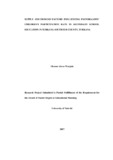| dc.description.abstract | The study considered the influence of demand and supply factors of education participation rate of nomadic children in secondary education in Turkana South Sub County. Participation rate in this regard was measured in terms of enrollment rates dropout rates, attendance levels, retention rates and completion rates. The research was guided by the following objectives, firstly to establish the influence poverty on nomadic children’s’ participation rate in secondary education, in Turkana South Sub-county, Kenya, secondly to establish the influence of gender
disparities on nomadic children’s’ participation rate on secondary education, to establish the influence of the formal secondary education curriculum, on nomadic children’s participation rate in secondary education and finally establish the influence of teacher- students’ ratio on nomadic children’s participation rate in secondary education. The research adopted two theories, Human Capital Theory and Social Theories, The results suggest that formal education in Kenya has not effectively served the nomadic communities. Education indicators in Turkana
County revealed that nomadic groups are at the bottom in national statistics pertaining to enrollment rates, school participation, and classroom performance, gender balance, and student’s achievement, progression to the next level of education and by extension training .The research concluded that pastoralists’ low participation rate and their perceived resistance to formal education is not about an attribute of incompatibility between pastoralism and education. On the contrary, the perceived resistance is about the aspect to provide formal education in a solely school-based system. It is about schooling in a ‘school’ setting, irrespective of the environment, rather than the formal education itself per se
that is sticky. The research recommends that Government of Kenya and other sector players must come up with ways of analyzing the obstacles that cause inequalities faced by pastoralist, in and outside the school and come up with policies that will keep learners in school focusing on gender disparities, reduction of poverty, customizing the curriculum to address the needs of the pastoralists
and reducing the teacher student ratios. | en_US |



